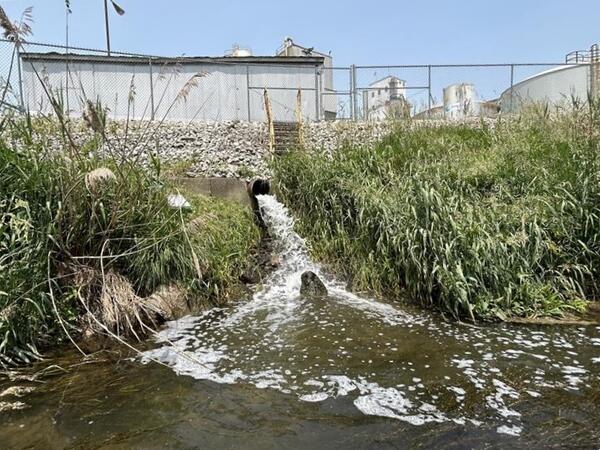Ethanol from seed corn is a type of biofuel produced by converting the starches and sugars in corn kernels into ethanol, a renewable energy source.
Multimedia
One-stop collection of videos, photography, and audio. All items in this gallery are considered public domain unless otherwise noted.
Images
Ethanol from seed corn is a type of biofuel produced by converting the starches and sugars in corn kernels into ethanol, a renewable energy source.

Treated Wastewater from Soybean Processing Facility
Treated Wastewater from Soybean Processing FacilityEffluent from soybean processing facility following treatment, entering nearby surface water body. Photo taken by USGS, Sandra Leal.
Treated Wastewater from Soybean Processing Facility
Treated Wastewater from Soybean Processing FacilityEffluent from soybean processing facility following treatment, entering nearby surface water body. Photo taken by USGS, Sandra Leal.
America’s diverse ecosystems are an asset to current and future generations by supporting economically and recreationally important fish, wildlife, and lands. Healthy ecosystems support people and nature, fostering prosperity and enjoyment for all.
America’s diverse ecosystems are an asset to current and future generations by supporting economically and recreationally important fish, wildlife, and lands. Healthy ecosystems support people and nature, fostering prosperity and enjoyment for all.
America’s diverse ecosystems are an asset to current and future generations by supporting economically and recreationally important fish, wildlife, and lands. Healthy ecosystems support people and nature, fostering prosperity and enjoyment for all.
America’s diverse ecosystems are an asset to current and future generations by supporting economically and recreationally important fish, wildlife, and lands. Healthy ecosystems support people and nature, fostering prosperity and enjoyment for all.

Multidisciplinary approach to prioritize critical elements for environmental research
Multidisciplinary approach to prioritize critical elements for environmental researchThis infographic introduces an approach that could subsequently be used to prioritize environmental research for the full range of critical elements.
Multidisciplinary approach to prioritize critical elements for environmental research
Multidisciplinary approach to prioritize critical elements for environmental researchThis infographic introduces an approach that could subsequently be used to prioritize environmental research for the full range of critical elements.

Produced‐water management options and potential routes of exposure
Produced‐water management options and potential routes of exposureA general summary of produced‐water management options and potential routes of exposure.
Produced‐water management options and potential routes of exposure
Produced‐water management options and potential routes of exposureA general summary of produced‐water management options and potential routes of exposure.
Videos
This animated nitrogen fixation video provides an overview of natural and industrial nitrogen fixation, along with benefits, costs, trends, and effects on ecosystems.
This animated nitrogen fixation video provides an overview of natural and industrial nitrogen fixation, along with benefits, costs, trends, and effects on ecosystems.
This animated nitrogen fixation video provides an overview of natural and industrial nitrogen fixation, along with benefits, costs, trends, and effects on ecosystems.
This animated nitrogen fixation video provides an overview of natural and industrial nitrogen fixation, along with benefits, costs, trends, and effects on ecosystems.
 The Animated Nitrogen Cycle - a diagram with many arrows and elements are shown.
The Animated Nitrogen Cycle - a diagram with many arrows and elements are shown.
This animation of the biogeochemical nitrogen cycle illustrates the main steps of the cycle in air, water, and soils. The video explains and connects the many forms of nitrogen, such as ammonia, ammonium, hydroxylamine, nitrite, nitrate, nitrous oxide, and nitrogen dioxide, and explains the role of nitrate in nitric oxide signaling in the human body.
This animation of the biogeochemical nitrogen cycle illustrates the main steps of the cycle in air, water, and soils. The video explains and connects the many forms of nitrogen, such as ammonia, ammonium, hydroxylamine, nitrite, nitrate, nitrous oxide, and nitrogen dioxide, and explains the role of nitrate in nitric oxide signaling in the human body.
 The Animated Nitrogen Cycle - a diagram with many arrows and elements are shown.
The Animated Nitrogen Cycle - a diagram with many arrows and elements are shown.
This animation of the biogeochemical nitrogen cycle illustrates the main steps of the cycle in air, water, and soils. The video explains and connects the many forms of nitrogen, such as ammonia, ammonium, hydroxylamine, nitrite, nitrate, nitrous oxide, and nitrogen dioxide, and explains the role of nitrate in nitric oxide signaling in the human body.
This animation of the biogeochemical nitrogen cycle illustrates the main steps of the cycle in air, water, and soils. The video explains and connects the many forms of nitrogen, such as ammonia, ammonium, hydroxylamine, nitrite, nitrate, nitrous oxide, and nitrogen dioxide, and explains the role of nitrate in nitric oxide signaling in the human body.
Juvenile Coho salmon (Oncorhynchus kisutch) exhibiting abnormal behaviors associated with exposure to 6PPD-quinone, a derivative of the compound 6PPD which is used in tires to prevent wear.
Juvenile Coho salmon (Oncorhynchus kisutch) exhibiting abnormal behaviors associated with exposure to 6PPD-quinone, a derivative of the compound 6PPD which is used in tires to prevent wear.
 U.S. Geological Survey. Laboratory for the Analysis of Per-and Polyfluoroalkyl Substances (PFAS)
U.S. Geological Survey. Laboratory for the Analysis of Per-and Polyfluoroalkyl Substances (PFAS)
USGS Laboratory for the Analysis of Per- and Polyfluoroalkyl Substances (PFAS)
USGS Laboratory for the Analysis of Per- and Polyfluoroalkyl Substances (PFAS)The U.S. Geological Survey laboratory for the analysis of per- and polyfluoroalkyl substances (PFAS) uses cutting-edge techniques to analyze environmental samples including tissues, plasma, water, and soils to undertake and support research projects across the country.
USGS Laboratory for the Analysis of Per- and Polyfluoroalkyl Substances (PFAS)
USGS Laboratory for the Analysis of Per- and Polyfluoroalkyl Substances (PFAS)The U.S. Geological Survey laboratory for the analysis of per- and polyfluoroalkyl substances (PFAS) uses cutting-edge techniques to analyze environmental samples including tissues, plasma, water, and soils to undertake and support research projects across the country.







